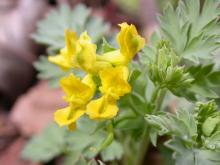Wildflowers, Grasses and Other Nonwoody Plants
Media

Species Types
Scientific Name
Kummerowia stipulacea (formerly Lespedeza stipulacea)
Description
Korean lespedeza is an Asian clover that was introduced to North America to prevent erosion, to feed wildlife and livestock, and, since it is a legume, to add nitrogen to the soil. A weedy plant, it has spread statewide since the 1930s.
Media

Species Types
Scientific Name
Verbascum thapsus
Description
Mullein immigrated to America along with Europeans, and with them it has spread across the continent. Its fuzzy, green-gray rosettes of leaves and tall spikes of yellow flowers make it easy to identify.
Media

Species Types
Scientific Name
Verbascum blattaria
Description
Moth mullein is a native of Eurasia introduced to our continent in the early 1800s. Since then, it has spread across North America. It’s named because the fuzzy flower, with 2 antennalike stamens, looks something like a moth.
Media

Species Types
Scientific Name
Ruellia strepens
Description
Although the funnel-shaped, 5-lobed flowers look something like the petunias you find at garden centers, our wild petunia is not related to them. This ruellia often has crinkled hairs in 2 narrow, lengthwise bands on opposite sides of the stalk.
Media

Species Types
Scientific Name
Perilla frutescens
Description
Introduced as an ornamental, beefsteak plant is native to Asia. It is common in moist or dry wooded bottomlands, open valley pastures, and along trails, railroads, and roadsides. It spreads invasively in our state.
Media

Species Types
Scientific Name
Impatiens capensis
Description
Many Missouri children learn about this orange-flowered native plant by playing with the juicy green seedpods, which, when ripe, "explode" upon the slightest touch. This is jewelweed's mechanism for seed dispersal, and it's the reason for the name "touch-me-not."
Media

Species Types
Scientific Name
Impatiens pallida
Description
Our two Missouri jewelweeds occur in the same habitats, often side by side, and even botanists can’t tell them apart without the flowers. Pale touch-me-not is the one with the lemon-yellow flowers!
Media

Species Types
Scientific Name
Lamium amplexicaule
Description
In early spring, henbit carpets entire fields with the pinkish-purple of its small flowers. This nonnative mint spreads abundantly but causes few problems. It has shallow roots and fades before crops begin to grow.
Media

Species Types
Scientific Name
Corydalis flavula
Description
The smooth, finely divided, fernlike foliage of pale corydalis is similar to that of the related wildflower Dutchman’s breeches. But in pale corydalis, the small yellow flowers appear tubelike and lipped.
Media

Species Types
Scientific Name
Delphinium carolinianum
Description
Small blue, lavender, or white flowers shaped like cornucopias dance along the tall stems of this Carolina larkspur, which grows in prairies and grasslands.
See Also
About Wildflowers, Grasses and Other Nonwoody Plants in Missouri
A very simple way of thinking about the green world is to divide the vascular plants into two groups: woody and nonwoody (or herbaceous). But this is an artificial division; many plant families include some species that are woody and some that are not. The diversity of nonwoody vascular plants is staggering! Think of all the ferns, grasses, sedges, lilies, peas, sunflowers, nightshades, milkweeds, mustards, mints, and mallows — weeds and wildflowers — and many more!





















